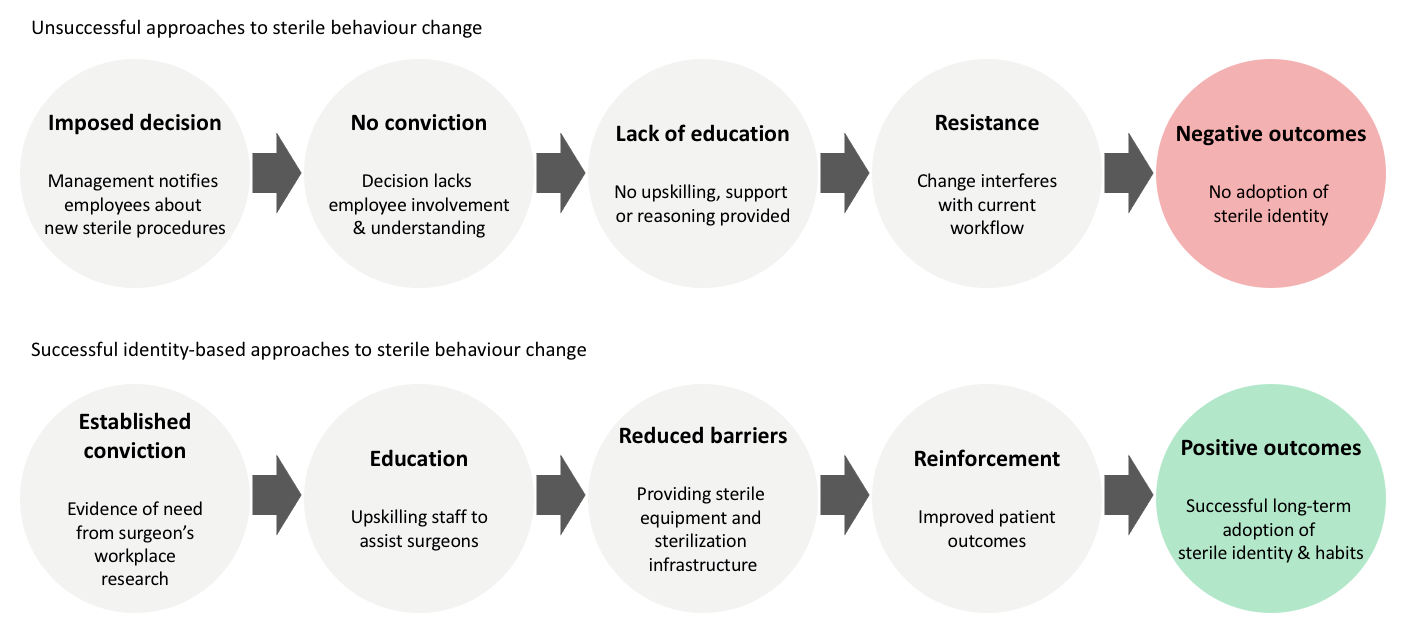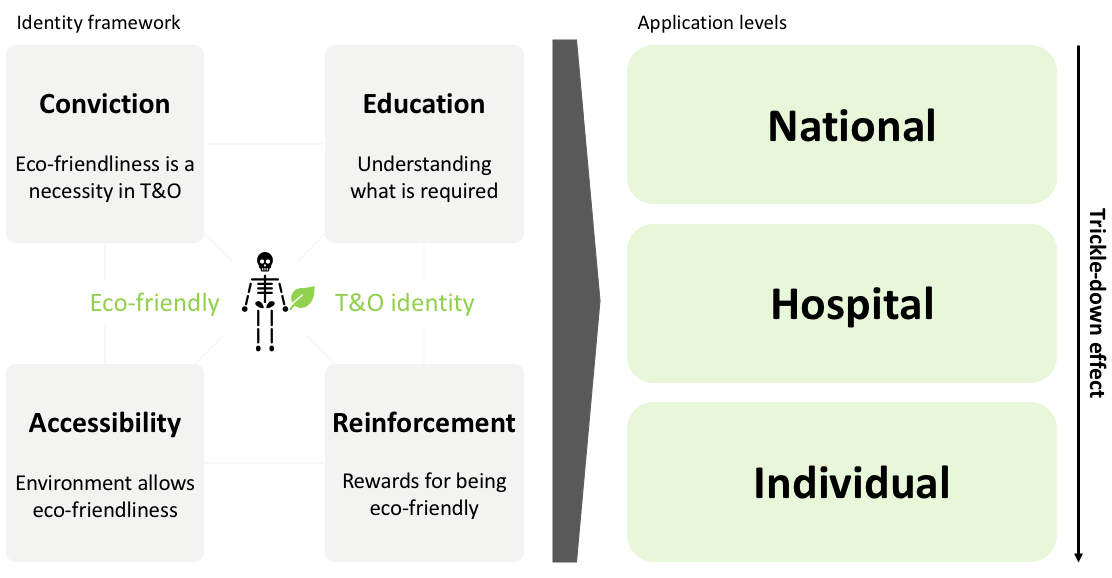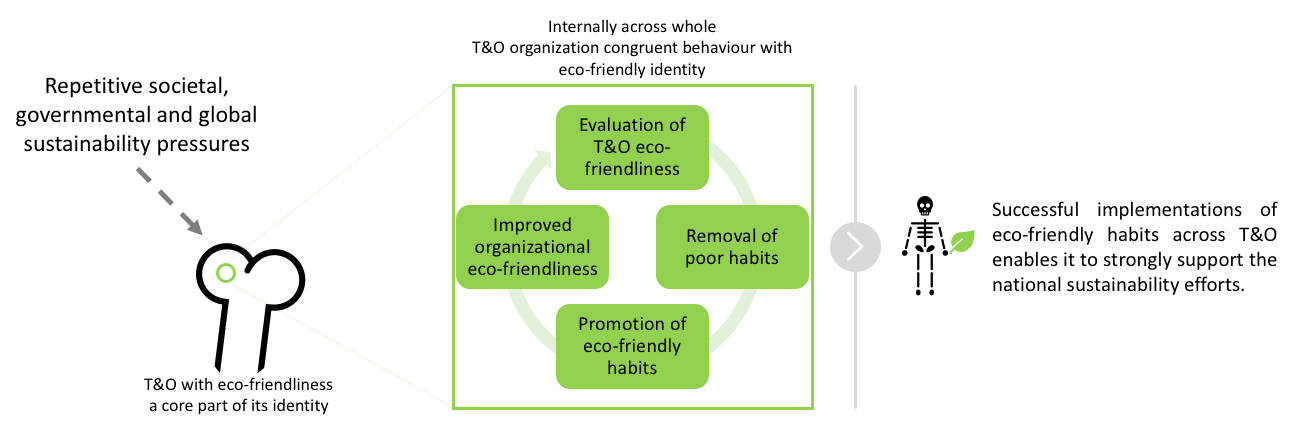“Eco-Wolff’s law”: Identity-based sustainable adaptation of trauma and orthopaedics
By Jan Drmota
Final year medical student at Imperial College London
|
This is the winning essay from the 2022 BOA Medical Student Essay Prize How can we make Trauma & Orthopaedics in the UK more Eco-friendly? |
Introduction
Repetitive societal, governmental and global forces are pressing organisations to adopt eco-friendly practices1. To counter the environmental impacts2, the NHS has joined the UK’s sustainability efforts by pledging a net zero NHS Carbon Footprint by 20403. The Royal College of Surgeons has admitted this will be challenging4.
For Trauma & Orthopaedics (T&O) to play its part in the effort as one of the largest surgical specialties in the UK5, a rigid framework is necessary to meet the objectives and overcome barriers to change. The primary objective is successfully enacting eco-friendly change, rather than just identifying areas of change. It is estimated that 70% of change programmes fail in business6,7,8. Individual behaviour changes are also difficult to maintain9. This becomes exponentially more difficult with sustainability changes that disrupt our current social, cultural and business paradigms10. For better outcomes the framework must be centred around T&O employees, rather than the issuance of managerial decisions6.
By not attempting change, T&O risks buckling under pressure and contributing to the global environmental devastation. Furthermore, the eco-friendly efforts may support better health outcomes11, which will only multiply the positive outcomes. Caution must always be made to maladaptive approaches that could fragment patient safety; patient wellbeing must always take precedence over change.
Eco-friendly identity framework
Successfully adopting organisational change involves overcoming the main resistor: its people. Accounting frameworks like the triple bottom line12, while quantitatively useful for managerial tracking, do not help employees. After an exhausting night shift sandwich meal, the marginal triple bottom line improvement is not a sufficient motivator for you to look for a recycling bin. Instead, T&O must remodel from within and create a culture where eco-friendliness is at the core of its identity. Identity-based motivation has become a popular approach in self-help books, psychology and business to adopting and maintaining new behaviours13,14,15. At its core, change will only happen if the conviction and desire for eco-friendliness becomes congruent with the individuals’ identities13,14,15, rather than being a set of imposed rules. Now you will look for the recycling bin as part of your eco-friendly identity habit. An example of this could be the historical adoption of sterile aseptic practices16 into the surgeon’s identity as summarised in Figure 1.

Figure 1: Illustrative example of sterile identity adoption and subsequent behavioural congruence.
Adapted from other identity-based approaches6,7,8, there are four key aspects to developing an eco-friendly identity in T&O: 1) establishing eco-friendly conviction; 2) facilitating conviction through education; 3) reducing barriers to eco-friendliness; and 4) reinforcement through rewards. The framework must be adopted across all levels of T&O as illustrated in Figure 2.

Figure 2: Eco-friendly identity and its adoption across T&O.
Once adopted in T&O, all practices will incorporate eco-friendliness since it will be congruent with the new identity13,14,15.
National
The British Orthopaedic Association has expressed its conviction of the need for an eco-friendly transition with this essay competition and other efforts17.
Transitioning to digital national orthopaedic conferences would not only reduce the carbon footprint of the event18, but it would also educate the T&O community that digitisation is viable and applicable. Furthermore, a dedicated eco-friendly theme for abstract submissions should be implemented. National recognition of the research would reinforce eco-friendly efforts at lower organisational levels. The exchange of eco-friendly knowledge would increase accessibility to eco-friendly change across the country.
Implementing digital technologies in T&O training would familiarise future surgeons with the environment and provide an avenue for innovation, driving eco-friendliness. Making eco-friendliness part of medical school conferences would establish it as a core pillar in its marketing.
These efforts would highlight to the greater T&O community that eco-friendliness is an integral part of the specialty and it would become a key factor in every process or decision. It would role model for hospitals across the country to also adopt this identity.
Hospital
Theatre equipment supply chains should favour locally sourced and reusable equipment, reducing environmental impact. Evidence supports the cost and durability benefits of reusable gowns versus disposable19. Reusable surgical hats, masks and shoes should also be implemented20. Furthermore, surgical tray optimisation has been considered as an important source waste21. These should be best optimised to reduce unnecessary unpacking of equipment and implementing mostly reusable equipment. Hospitals should learn from countries where scarcity is a necessity and adopt sustainable practices that do not affect patient safety, for example repurposing equipment already owned22. 3D printed implants, if of equal performance, can be adopted since their production significantly reduces waste and cost23. Anaesthetic gas should be reduced to a minimum due to its polluting effects20.
Digitisation in the outpatient-department has been shown to be eco-friendly and even increases satisfaction in some cases24.
Hospital infrastructure should be made with eco-friendliness in mind: recycling bins accessible everywhere, renewable food packaging, motion sensor lighting. Patient lists and journeys should be optimised to minimise resource wasting in between procedures.
For successful adoption, hospitals must run trial simulations with new eco-friendly equipment to verify and convince everyone of the benefits and upskill staff to using them while reducing barriers.
Individual
A trickle-down effect will be observed from the national and hospital level identity adoptions. This will facilitate the conviction of the individuals about the necessity for change. The eco-friendly T&O environment will facilitate discussions between individuals, educating about eco-friendly topics.
Public transportation or cycling should be incorporated into daily routines. Challenges and competitions between individuals should be set up to reward those who are most eco-friendly, as gamification has been associated with increased adherence in various settings25.
Conclusion
Highlighting where T&O can adopt eco-friendly practices is not difficult. The challenge is overcoming barriers to behaviour change and achieving long-term eco-friendliness in a short time-period. Once T&O adopts eco-friendliness as a core part of its identity, the adaptation of the organisation will become a completely natural process that will result in it being a strong contributor to the national sustainability efforts, as summarised in Figure 3.

Figure 3: Natural eco-friendly adaptation when T&O adopts new identity and congruent habits.
References
- Boston Consulting Group. Sustainability. Available at: www.bcg.com/capabilities/social-impact-sustainability/approach-to-sustainability.
- World Wide Fund for Nature. Effects of Climate Change. Available at: www.worldwildlife.org/threats/effects-of-climate-change.
- National Health Service England. Delivering a ‘Net Zero’ National Health Service. Available at: www.england.nhs.uk/greenernhs/wp-content/uploads/sites/51/2020/10/delivering-a-net-zero-national-health-service.pdf.
- Royal College of Surgeons of England, Sustainability in Surgery. Available at: www.rcseng.ac.uk/about-the-rcs/about-our-mission/sustainability-in-surgery.
- Royal College of Surgeons of England. Surgery and the NHS in numbers. Available at: www.rcseng.ac.uk/news-and-events/media-centre/media-background-briefings-and-statistics/surgery-and-the-nhs-in-numbers.
- Boston Consulting Group. Putting People at the Center of Change. Available at: www.bcg.com/en-gb/capabilities/business-transformation/change-management/putting-people-center-change
- Harvard Business Review. Cracking the Code of Change. Available at: https://hbr.org/2000/05/cracking-the-code-of-change.
- McKinsey & Company. Changing change management. Available at: www.mckinsey.com/featured-insights/leadership/changing-change-management.
- Bouton ME. Why behavior change is difficult to sustain. Prev Med. 2014;68:29-36.
- Cancialosi C. Why Many Culture Efforts Struggle To Drive Sustainable Change. Forbes. Available at: www.forbes.com/sites/chriscancialosi/2019/04/16/why-many-culture-efforts-struggle-to-drive-sustainable-change/?sh=594b31e5136b.
- Mitchell R, Popham F. Greenspace, urbanity and health: relationships in England. J Epidemiol Community Health. 2007;61(8):681-3.
- Slaper T., The Triple Bottom Line: What Is It and How Does It Work? Indiana Business Review. Available at: www.ibrc.indiana.edu/ibr/2011/spring/article2.html.
- Clear J., Atomic Habits: An Easy & Proven Way to Build Good Habits & Break Bad Ones.
- Oyserman D, Destin M. Identity-Based Motivation: Implications for Intervention. Couns Psychol. 2010;38(7):1001-43.
- McKinsey & Company. The four building blocks of change. Available at: www.mckinsey.com/business-functions/people-and-organizational-performance/our-insights/the-four-building-blocks--of-change.
- Nakayama DK. Antisepsis and Asepsis and how They Shaped Modern Surgery. Am Surg. 2018;84(6):766-71.
- British Orthopaedic Association. About Us. Available at: www.boa.ac.uk/about-us.html.
- Tao Y, Steckel D, Klemeš J, You F. Trend towards virtual and hybrid conferences may be an effective climate change mitigation strategy. Nat Commun. 2021;12(1):7324.
- McQuerry M, Easter E, Cao A. Disposable versus reusable medical gowns: A performance comparison. Am J Infect Control. 2021;49(5):563-70.
- McGain F, Muret J, Lawson C, Sherman J. Environmental sustainability in anaesthesia and critical care. Br J Anaesth. 2020;125(5):680-92.
- Ahmadi E, Masel D, Metcalf A, Schuller K. Inventory management of surgical supplies and sterile instruments in hospitals: a literature review. Health Syst (Basingstoke). 2019;8(2):134-51.
- O'Hara N. Is safe surgery possible when resources are scarce? BMJ Qual Saf. 2015;24(7):432-4.
- Yadav D, Garg R, Ahlawat A, Chhabra D. 3D printable biomaterials for orthopedic implants: Solution for sustainable and circular economy. Resources Policy. 2020;68;101767.
- Pradhan R, Peeters W, Boutong S, Mitchell C, Patel R, Faroug R, Roussot M. Virtual phone clinics in orthopaedics: evaluation of clinical application and sustainability. BMJ Open Qual. 2021;10(4):e001349.
- De Croon R, Geuens J, Verbert K, Vanden Abeele V. A Systematic Review of the Effect of Gamification on Adherence Across Disciplines. Lecture Notes in Computer Science. 2021;12789:168-84.
